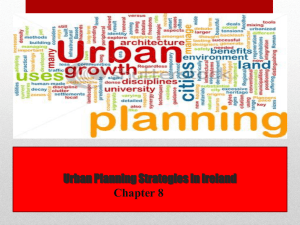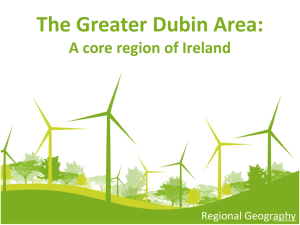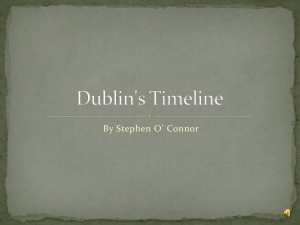Greater Dublin Area - Scoil Mhuire Geography
advertisement
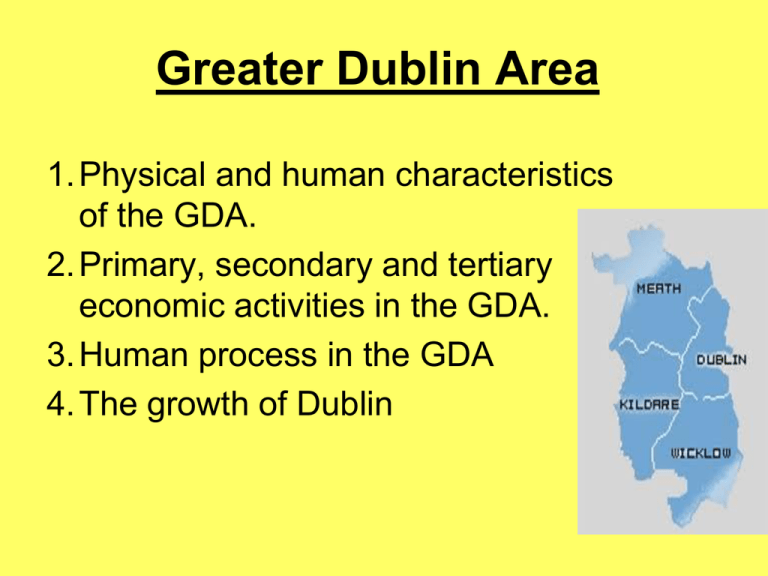
Greater Dublin Area 1. Physical and human characteristics of the GDA. 2. Primary, secondary and tertiary economic activities in the GDA. 3. Human process in the GDA 4. The growth of Dublin Route Focus/Nodal point. International airport and two ports Natural resources – fertile brown earth soils. Drained. Coastlne provides sheltered harbours for the fishing industry and tourism. Dublin is financial and administrative capital. Services centre and popular tourist destination. Core Economic Region High population density. Area of in migration. Wealthy, educated population. Soils Relief and Drainage Mainly covered by fertile brown earth soils. Low lying relief – perfect for commerical agriculture. Coastline has various rock types and erosion is a problem. North Co. Dublin deposition from the sea has added sand to the brown earth making them suitable for intensive horticulture. Climate Drier than the BMW. Average annual rainfall is approx 750mm which is almost 1000mm less than BMW. January 5°C July 15°C Well drained – R.Liffey, R. Boyne Physical Factors of the GDA Population Dublin City higher than average population density… why? Highly skilled workforce – UCD, DCU. Human factors Transport Developed transport network. large volumes of commuter and business traffic. Many industries have moved to industrial estates as transport costs are so expensive. In this location they can access the M50. Public transport is devleoped LUAS and DART. Government/ EU Policy Dublin is the natural focus for foreign and government investment. Several government agencies are responsible for directing EU and government funds to the GDA region e.g. IDA and Dept of Agriculture, Fisheries and Food (CAP and CFP) Primary Economic Activities Agriculture Over 19,000 farmers – 123,000 in the BMW. Farmers make a better living due to the fertile soil and favourable climate. Large intensive commerical farms with an above average size of 42.3 hectares. Farmers are young, educated and less traditional than in the BMW. Physical Factors • Mild climate allows a long growing season for grass = beef farming is the most common activity for the region • 3,800 beef cattle farmers in the region. Receive young cattle from the BMW and fatten them in the GDA. • Variety of fertile well drained loam, boulder clay and sandy soils. Allows for cereal growing in Meath and greenhouse horticulture in Rush and Lusk in North County Dublin. • Land is low lying and gently rolling which allows for intenseive mechanised agriculture in Meath and Kildare. • In Wicklow, where land is mountaneous farms are small. Sheep and forestry are the main activities. • Successful mixed grazing livestock, tillage and horticulture. Up to €53.1m cereal production and over €140m from cattle production per year. • The drier, frost free climate allows a longer growing season and outdoor vegetable production. • Kildare places special emphasis on the bloodstock industry (horse). • Well drained glacial outwash sand and gravel soils are world famous for breeding, rearing and training horses e.g. the Curragh. • Low land parts of Wicklow are also beef and tillage. • The good quality soils and demand for fresh produce mean farmers in the GDA have not turned to forestry as a second source of income. Human Factors • Capital, markets, transport, funding and education all mean farms are highly mechanised and yields are high. • Large markets of Dublin, Drogheda, Arklow and Navan. • Good transport links, low costs and short distances ensures fragile perishable fruit and vegetables arrive from the greenhouses to the markets. • Since recession there has been a reduction in jobs and many labourers have left the sector. • Farmers receive funding from the EU where CAP contributes to the education and training of young farmers through Teagasc and the Department of Agriculture. Forestry • Much of the low land have more fertile soils and the land is used for commerical agriculture. • Wicklow mountains have thin acidic soils, wetter climate and steeper ground. Forestry is a better use of this land. • Few farmers turn to forestry Fishing • Fishing industry is based at Howth. Dublin city is also ranked third in the number of people employed in fish processing. • Dublin Bay Prawns account for 40% of the value of shellfish exports from Ireland. France, Spain and Britain are the main markets. Mineral Resources • Since 1960 ireland has had a string of lead and zinc metal discoveries. Ireland is ranked first in the world for zinc discovered per sqkm and second for lead. • Ireland has three underground lead and zinc mines in production. The largest of these is in the GDA in Navan Co. Meath. This is the largest lead and zinc mine in Europe and employs over 600 people. Secondary Economic Activities Physical factors • On the east coast close to the UK and Europe. • Dublin bay is a naturally sheltered harbour and has been a port location since Viking times. • The hinterland of Dublin is fertile farmland which provides raw materials for the food processing industries Human Factors • Dublin city is the focus of Ireland’s transport network. Connected to all parts of the country by road and rail, international connections by air and sea. • High population density and a young population. 43% are under 25 years of age – provides a labour force and market. • Dublin is a national education centre making it an attractive location for knowledge based industries such as IT. • Dublin is a services centre providing support services for industry – marketing and technical support. • People are generally wealthier in the GDA making it attractive to producers of high value luxury goods. Secondary Economic Activities • Wide range of manufacturing e.g. brewing, food processing, printing, clothing and electronics. No single industry has a major influence. • Dublin region accounts for over 90,000 jobs in manufacturing. • Location of many worldwide industries – Microsoft, IBM, HP and Intel. • Food processing – chocolate and biscuit making factories e.g. Cadburys and Jacobs . • Printing industry – The Independent Newspaper’s site at City West is a ‘state of the art’ plant. • Manufacturing is spread out around the GDA. Intel is located in Leixlip Co. Kildare. • However industry is moving away from its traditional location in the Dublin docklands to industrial estates and business parks –good transport links. Food Processing Industry: Largo Foods, Ashbourne, Co. Meath Irish company established in 1983. Leading manufacturer and distributor of snack foods (crisps, snacks, peanuts and popcorn) in Ireland. The brands produced include • Hunky Dory • Tayto • King • Perri • Sam Spudz Employs 360 people in its Ashbourne plant. 2010 company turnover was worth €95 million. Location • Ashbourne located around 20km north of Dublin on the N2 route way. The founder was a local potatoe grower in Meath who supplied manufacturers of snack food brands. • He gradually expanded his business and now his company, Largo Foods, owns the brands he once supplied. He located his food processing plant in his native town. Raw materials and Transport • Most raw materials arrive by lorry from Dublin port. The potatoes are supplied by Irish farmers in Meath, Dublin, Louth and Wexford. • 90% of potatoes are from farms within 30km of the plant. • Maize, used in products like chip-sticks and onion rings and corn for popcorn are grown in the Paris Basin region and are delivered by ship and lorry. Markets • Supplies to the Irish Market. • 20% of its business market is located in the UK. The products are shipped from Dublin port to the UK via Holyhead Activity • Go back over the case study of Largo Foods. • Discuss the physical and human factors that have helped develop this successful industry in the GDA. Tertiary Economic Activities 1. Transport 2. Tourism 3. Services Groupwork: think about the physical and human factors that have helped develop tertiary economic activities in the GDA • Dublin dominates tertiary economic activities in the GDA because of its size and how it is growing rapidly. • However certain services are much more important in the GDA than in the BMW region • 21% of the workforce in Dublin is employed in professional services (Finance, healthcare, teaching and legal work) compared to 17% in Donegal. This is because there is a greater demand for these services. Transport and Communications • GDA transport centre of Ireland. All routes focused on Dublin. • Transport and communication related work accounts for 9% of employment in the GDA. • Due to high population density the transport network is overcrowded and congestion is a problem. • Major investment in rail, road and air links have taken place under the Transport 21 project. Transport 21 • Aims to upgrade key routeways across Ireland and especially in the Dublin region. • Terminal 2 at Dublin airport is completed and caters for over 15 million passengers per year. The Dublin port tunnel has reduced heavy traffic on city centre streets while the DART and LUAS lines have been extended. The M50 upgrade and the introduction of barrier free tolling has reduced journey times. • In the city Quality Bus Corridors have enabled faster bus journeys and the Dublin Bike Scheme has been a success with over 1million uses recorded. • The completion of motorway links to Belfast (M1), Galway (M6) and Cork (M8) has made Dublin even more accessible. Communications • The information, communications and technology sector (ICT) is leading Ireland’s smart economy with 7 of the world’s top 10 ICT companies located in the GDA. • They rely on fast broadband connection, sales and financial services networks. Telesales is a growth sector in the GDA as a result of its broadband connection. Google has two centres in Dublin and Hertz has located its European call centre in Swords Co. Dublin. • The City West business campus is the location for Ireland’s National Digital Park. The park is being developed as a centre for ecommerce and technology companies who need high speed digital communications. Road Network – will have to mark in a main road into your sketch map Main River and airport – will have to add into your sketch maps Tourism • 2010 generated €4.6 billion for the Irish economy. • There were over 5.6 million overseas visitors to the Republic of Ireland in 2010 a decrease of over 11% on numbers for 2009 due to world economic recession. Friday 8th March http://www.independent.ie/lifestyle/travel/trav el-news/ireland-one-of-dearest-places-totake-holiday-29116908.html • Year round industry boasting different types of holidays e.g. culture and activity. • Most UK visitors arrive between October and March and Europe and America in the summer. • Dublin is Europe’s 4th most visited city. Seen as a weekend break destination where tourists are high spending. (2009 €1.5 billion for economy). • Dublin is a historical city with many museums, art galleries and historic buildings. €2 out of every €5 spent by tourists in Ireland is spent in the Dublin region. 33% of tourists are from mainland Europe, 25% are from the UK. Easily accessible through Dublin Airport with over 79 airlines operating to 207 destinations and over 450 flights per day. Ferry passengers use Dublin and Dun Laoghaire ports. • Famous for literary tradition as home to writers such as Jonathan Swift, William Butler Yeats and James Joyce. • Variety of attractions – castles and churches (Christ Church and St. Patrick’s Cathedral and cafes and clubs. Gaiety Theatre, shops (Dundrum Town Centre), restuarants, bars (Templebar) and music venues (O2) • Sport attracts many tourists – rugby Aviva Stadium, GAA at Croke Park and concerts in the O2 • Dublin is easy to get around on foot or by road, rail, river taxi and tram. Dublin’s rent a bike scheme has been a huge success. • Beyond Dublin city, scenic walks, historic locations and active holidays are available and are within easy reach of the capital with good road and rail links. Outside of Dublin • Physical factor – landscape and relief in Co. Wicklow. Glendalough and Powerscourt Waterfall for walking, cycling etc. Blue flag beaches e.g. Brittas Bay. • Co. Kildare – angling and golf facilities and the horseracing industries. The Curragh racecourse attracts many international visitors throughout the year. Punchestown racing festival is also important. • Co Meath is Ireland’s Heritage Capital. Rich in history with castle ruins (Trim Castle), stone circles and early Christian churches. World heritage site Newgrange. Other Services • Employment in public administration (eg the Gardaí, government departments) accounts for a large share of the workforce in Dublin city – administrative capital of the country. • Health services are another part of the tertiary sector. Dublin has 6 private and 15 public hospitals. IT Services in the GDA • Dublin is becoming the information technology capital of Europe. Reasons why they locate in Dublin 1. Young educated workforce. Overall 44% of the population has a third level qualification. 2. Dublin has affordable office space. Rents are now lower than ever in vacant office blocks 3. Government policy – corporation tax is 12.5% compared to 41% in Japan. Some examples Google, eBay, Linkedln, IBM, Hertz Population • 1.6million. • The number of young people (0-14) is expected to increase by 26% by 2021. • There is a surplus of females in the GDA which reflects the greater number of female workers in health and education. • The government will have to invest in more healthcare and childcare services. Will also need services for the elderly. • The number of older people will increase by 75% in Dublin. • Dublin has become a cultural melting pot. The number of religions practised in the country is increasing. There are two mosques in the city catering for the islamic population. • Because the government agencies dealing with immigration are located in Dublin it is the first stop for many immigrants. • 15% of the Dublin city population are foreign nationals. Planning Policies • NDP – Address traffic congestion, build on the citys economic success, develop tourism, maintain a viable rural economy, continue develop of transport links. • NSS – monitor the growth of Dublin, manage the location of industry and the zoning of land, develop the hinterland. Dublin is an Urban region • Can you list the characteristics of an urban region? Some key terms CBD Area of in – migration Primate cities Zone of transition – area where buildings are in disrepair and awaiting development. Nodal point Conurbations – groups of cities grow into each other. Urban Sprawl Growth of Dublin City In groups discuss 1. The reasons for the growth of Dublin. 2. The effects of this growth. Read the handout on the growth of Dublin as a group. Highlight the key terms. How many did your group think of?
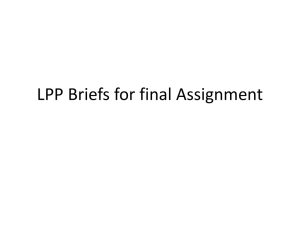
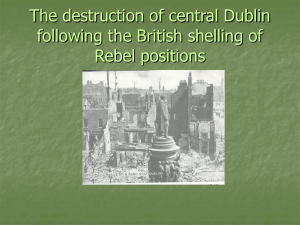
![South east presentation resources [pdf, 7.8MB]](http://s2.studylib.net/store/data/005225551_1-572ef1fc8a3b867845768d2e9683ea31-300x300.png)
